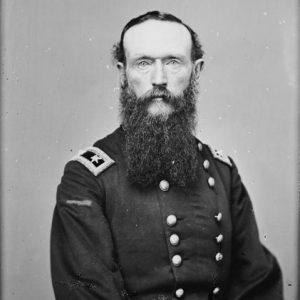calsfoundation@cals.org
Skirmish at Terre Noire Creek
aka: Skirmish at Antoine
aka: Skirmish at Wolf Creek
| Location: | Clark County |
| Campaign: | Camden Expedition |
| Date: | April 2, 1864 |
| Principal Commanders: | General Fredrick Steele (US); Brigadier General Joseph O. Shelby (CS) |
| Forces Engaged: | Twenty-ninth Iowa Volunteer Infantry, Fiftieth Indiana Infantry Regiment, Ninth Wisconsin Infantry Regiment, a detachment of Captain Martin Voegele’s Wisconsin Battery (US); detachment of Shelby’s Cavalry Division (CS) |
| Estimated Casualties: | 8 killed, 23 missing, 32 wounded (US); approximately 200 (CS) |
| Result: | Union victory |
The Skirmish at Wolf Creek, one of the engagements fought during the Camden Expedition, was fought one mile east of the Terre Noire Creek along a defile near the town of Antoine (Pike County). A Confederate detachment attacked a Union supply train of more than 200 wagons traveling toward Camden (Ouachita County) and guarded by the Twenty-ninth Iowa, as well as the Fiftieth Indiana and Ninth Wisconsin regiments. The skirmish was one of the earlier engagements associated with General Frederick Steele’s attempt to push south through Arkansas.
The Twenty-ninth Iowa was assigned as the rear guard of the main supply regiment with the Fiftieth Indiana as support. While moving across a defile caused by the Terre Noire Creek, the rear guard of the Twenty-ninth Iowa came under attack by a Confederate force of around 1,200 men (from a detachment of Joseph Shelby’s cavalry) attempting to flank the main supply train. The Twenty-ninth Iowa rear guard, with support from the left wing of the main Twenty-ninth Iowa regiment, quickly stopped the advance of the Confederate detachment. The remainder of the Twenty-ninth, under the direction of Colonel Thomas Benton (commander of the Twenty-ninth Iowa), crossed the defile and set in along either side of the road. Additionally, the battery under the command of Captain Martin Voegele was set into position and began to fire on the Confederates.
After a brief contest, the Confederate force fell back across the creek with the Twenty-ninth Iowa in pursuit. Once across the creek, in an attempt to prevent the Confederates from flanking his position, Col. Benton ordered an advance to a hill one mile from the creek. Just before the Twenty-ninth Iowa reached the apex of the hill, the Confederates attacked the rear flank of the Union force but were stopped by skirmishers. Once the Twenty-ninth Iowa reached the crown of the hill, an artillery position was once again established, and the remaining forces deployed. The Confederates made one last desperate charge up the hill, sustaining considerable casualties, but were once again pushed back.
During the initial Confederate attack, the Fiftieth Indiana was ordered to take a position at the rear of the Twenty-ninth Iowa, with the flanks secured by skirmishers. Shortly after the Fiftieth Indiana was in place, the Confederates attacked the left wing of the Union position in an attempt to capture the Federal artillery. As the Twenty-ninth moved to its hilltop location, one mile from Terre Noire Creek, the Fiftieth Indiana position was once again attacked by Confederate forces. Following the repulsion of the Confederate attack, the Fiftieth Indiana was ordered to fall back and secure the rear flank of the supply train. Under the direction of Lieutenant Colonel Samuel Well, commander of the Fiftieth Indiana, the regiment set in rear security for two miles under constant skirmishing. The Fiftieth Indiana was relieved as rear guard by the Ninth Wisconsin Regiment. The Fiftieth Indiana again came under attack on its right by Confederate forces. It counterattacked and drove the Confederates from the field. The Fiftieth was then ordered to resume the march. The regiment was barely in formation along the road when it received another attack from the Confederates along on the left. This attack, too, was repelled by the Fiftieth.
The Ninth Wisconsin was ordered to protect the Washington Road with four companies and to send three companies to protect the wagon train along a road that branched off the Washington Road toward Camden. Additionally, Colonel Charles Salomon, commander of the Ninth Wisconsin Infantry, stationed two artillery pieces under the command of Lieutenant D. Veidt. Around 5:00 p.m., the Fiftieth Indiana arrived at the wagon train, and four companies—H, E, G, and B—from the Ninth Wisconsin were ordered to take up rear security. As the detachment from the Ninth moved forward, it was attacked by a heavy Confederate cavalry force. The four-company detachment was forced to retreat to a hill along the road. Col. Salomon established a fighting position at the hill with two artillery pieces and the four companies. After fifteen minutes of fighting against a dismounted Confederate cavalry attack, the Fiftieth Indiana arrived at Salomon’s position as reinforcement. The Confederates were repulsed and fell back.
The march was resumed with the Ninth Wisconsin in the rear. The Confederates continued to attack the supply train until dark. The Union regiments arrived in camp near Okolona (Clark County) at 10:00 p.m.; Shelby would attack them there the next day.
Union casualties in the Skirmish at Terre Noire Creek were eight killed, twenty-three missing, thirty-two wounded. While the Confederates did not report any casualties at the time, John Newman Edwards, Shelby’s adjutant, wrote in a post-war account that “many old soldiers fell in this day’s battle—nearly two hundred— but the enemy suffered fearfully and the Confederates were satisfied.” Private Charles O. Musser of the Twenty-ninth Iowa Infantry Regiment (US), writing home after the fighting, stated that “our loss in the Battle: 67 men; rebble loss: over two hundred.”
For additional information:
Edwards, John N. Shelby and his Men: or, the War in the West. Waverly, MO: General Joseph Shelby Memorial Fund, 1993.
Forsyth, Michael J. The Camden Expedition of 1864 and the Opportunity Lost by the Confederacy to Change the Civil War. Jefferson, NC: McFarland & Company, Inc., 2003.
Popchock, Barry, ed. Soldier Boy: The Civil War Letters of Charles O. Musser, 29th Iowa. Iowa City: University of Iowa Press, 1995.
The War of the Rebellion: A Compilation of the Official Records of the Union and Confederate Armies. Series I, Vol. 34, pp. 699–703. Washington DC: Government Printing Office, 1891.
Jacob Worthan
Henderson State University


 ACWSC Logo
ACWSC Logo  Joseph Shelby
Joseph Shelby  Frederick Steele
Frederick Steele 



Comments
No comments on this entry yet.